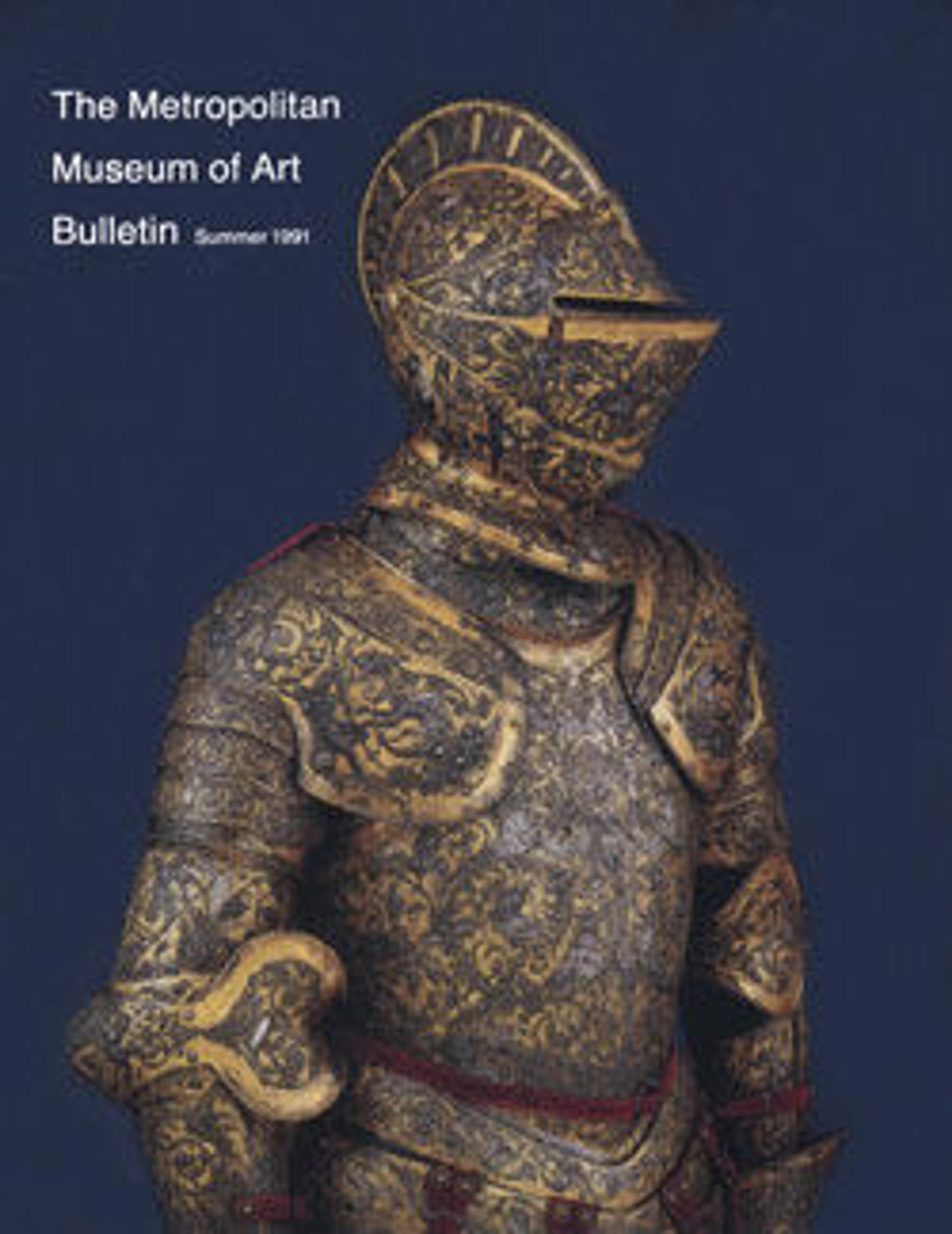Morion
Forged in one piece this helmet has a high comb across its rounded bowl and an elegantly swept brim rising to sharp points at the front and back. Cheekpieces with chin straps are built up from three overlapping plates. The decorative heads of the rivets securing the lining are lion's masks holding rings in their mouths; the rivet heads on the cheekpieces are brass rosettes. A brass plume holder in the shape of a winged female half-figurine is attached to the rear end of the comb. The entire surface is blackened except for etched and gilt bands of arabesques along the edges of brim and comb and circular medallions on bowl and comb. The smaller medallions on the comb show the arms of the Dukes of Saxony, barry of ten, or and sable, a crancelin vert in bend overall, on one side, and on the other those of the archmarshalship of the empire, per fess sable and argent, two swords gules in saltire overall. The large medallions on either side of the bowl show figural scenes from classical Roman history: the self-sacrifices of Marcus Curtius and of Mucius Scaevola.
Morions like this were once equipment of the personal guard––Trabantenleibgarde––of the Prince Electors of Saxony at Dresden, probably Christian I (reigned 1586–91). The colors black and gold were the livery colors of the Electors, taken from the arms of Saxony. The uniform of the guard was also black and yellow: black doublets and yellow trunk hose and stockings. The Trabantenleibgarde consisted of two companies, one mounted (on black horses) and one on foot, each about a hundred men strong. Great numbers of these morions were kept in the Dresden armory until the 1830s when a progressive-minded monarch ordered them to tbe sent to the opera house as stage props in an attempt to rid the armory of too much clutter. Alert dealers rescued them from the ignominous fate of slowly perishing in the obscurity of backstage shelves, and today they are prized collector's objects.
This morion is stamped with the proofmark of the armorers' guild of Nuremberg and a master's mark, M R, probably the mark of Martin Rothschmied (died 1597).
Morions like this were once equipment of the personal guard––Trabantenleibgarde––of the Prince Electors of Saxony at Dresden, probably Christian I (reigned 1586–91). The colors black and gold were the livery colors of the Electors, taken from the arms of Saxony. The uniform of the guard was also black and yellow: black doublets and yellow trunk hose and stockings. The Trabantenleibgarde consisted of two companies, one mounted (on black horses) and one on foot, each about a hundred men strong. Great numbers of these morions were kept in the Dresden armory until the 1830s when a progressive-minded monarch ordered them to tbe sent to the opera house as stage props in an attempt to rid the armory of too much clutter. Alert dealers rescued them from the ignominous fate of slowly perishing in the obscurity of backstage shelves, and today they are prized collector's objects.
This morion is stamped with the proofmark of the armorers' guild of Nuremberg and a master's mark, M R, probably the mark of Martin Rothschmied (died 1597).
Artwork Details
- Title:Morion
- Date:ca. 1600
- Geography:Nuremberg
- Culture:German, Nuremberg
- Medium:Steel, gold, pigment, brass, textile
- Dimensions:H. 14 in. (35.6 cm); W. 9 7/16 in. (24 cm); D. 15 in. (38.1 cm); Wt. 4 lb. 1 oz. (1865 g)
- Classification:Helmets
- Credit Line:Rogers Fund, 1904
- Object Number:04.3.224
- Curatorial Department: Arms and Armor
More Artwork
Research Resources
The Met provides unparalleled resources for research and welcomes an international community of students and scholars. The Met's Open Access API is where creators and researchers can connect to the The Met collection. Open Access data and public domain images are available for unrestricted commercial and noncommercial use without permission or fee.
To request images under copyright and other restrictions, please use this Image Request form.
Feedback
We continue to research and examine historical and cultural context for objects in The Met collection. If you have comments or questions about this object record, please contact us using the form below. The Museum looks forward to receiving your comments.
